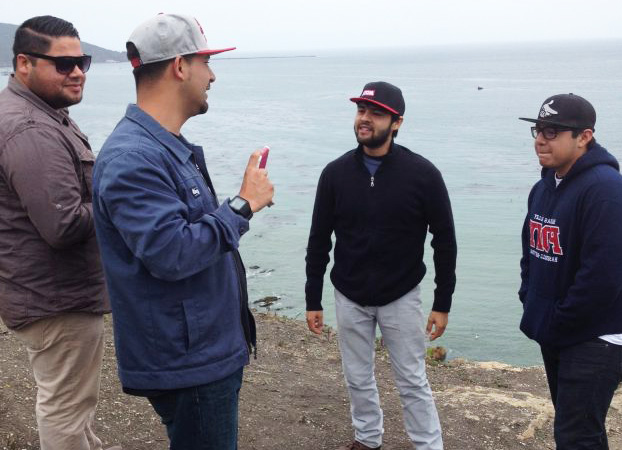INCARCERATED AS TEENAGERS, THESE MEN BRING PASSION AND EXPERIENCE TO THEIR NEW JOB OF HELPING DIRECT CALIFORNIA’S FUTURE JUVENILE JUSTICE POLICY
When Juan Gomez first arrived at a notorious California youth prison in rural Amador County at the age of 16, he remembers an acute sense of powerlessness.
Guards at the Preston Youth Correctional Facility patrolled the grounds with impunity, meting out beatings and macings to the youth locked up there.
Gomez, now 34, remembers cold, hungry nights in the dungeon-like Tamarack Hall, the high-security wing at Preston where many detainees spent 23 hours a day in solitary confinement or kept in metal cages. Grievances filed by youth at Preston went mostly unanswered.
The distance between Gomez and his captors felt vast. Guards monitored their young charges from atop a tower, hidden by a shield of dark Plexiglass.
“You couldn’t really see inside,” Gomez said. “You had no idea what would happen because they had all the power.”
Although Preston was shuttered in 2011, California’s juvenile justice system is still in need of reform. Gomez is planning on making his voice heard.
Starting this year, he’ll be working at one of the highest levels of California state government, with a seat on the State Advisory Committee on Juvenile Justice and Delinquency Prevention (SACJJDP).
But Gomez won’t be alone. He’ll be coming aboard along with three other young men with personal experiences of incarceration in the state’s juvenile justice system. Appointed by Gov. Jerry Brown, Kent Mendoza, Miguel Garcia and Ramon Leija will join Gomez on the SACJJDP. James Anderson, who was also incarcerated as a youth, has served on the committee since last year.
Part of the state’s Board of State and Community Corrections (BSCC), the SACJJDP helps develop the state’s juvenile justice plan, providing input to the governor and the legislature while making sure juvenile justice programs across counties are compliant with federal and state law.
The BSCC meets today for the first time this year in San Diego, and the addition of a crop of formerly incarcerated youth to a BSCC committee that helps direct juvenile policy is a bracing moment for justice advocates in the state.
The little-known BSCC monitors the way billions of dollars are spent on incarceration in California, along with measuring outcomes, data collection and oversight of conditions at state correctional facilities, including juvenile camps, halls and ranches.
The BSCC and many of its committees – like the SACJJDP – are heavily stocked with members of the state’s law enforcement agencies. But it is far less common for the state to hear the perspective of youth in the justice system and those who have previously experienced incarceration at the Sacramento-based agency, according to juvenile justice advocates.
Frankie Guzman, a juvenile justice attorney with the National Center for Youth Law with his own story of surviving a stint in a state prison as a youth, said criminal justice systems have been slow to incorporate the voices of formerly incarcerated youth.
“For a long time, their voice was ignored and they have a side of story that has rarely been heard,” Guzman said.
Guzman said that the selection of five youth to the SACJJDP shows that California is leading the way toward providing a model of decision-making that values the perspective of young people who have a deep knowledge of the system and how it works. But the inclusion of voices like Gomez, Mendoza, Garcia and Leija on the state body also sends a powerful message to youth in the more than 100 juvenile detention facilities across the state.
“It signals to all the youth who are exiting the justice system that you do have some value, you’re not a leper, you’re not a person who we want to marginalize and want to keep at the fringes,” Guzman said.
That lesson is not lost on Gomez.
Since exiting the California Youth Authority-run (now known as the Division of Juvenile Justice) facility at age 22, Gomez has channeled his experiences there into forming Motivating Individual Leadership for Public Advancement (MILPA). The Salinas organization works with troubled youth and young adults who have recently exited incarceration, using cultural healing practices to create systems change.
By participating in the SACJJDP, Gomez hopes to show that people who have experienced incarceration can offer fresh insight and solutions to the issues facing youth in the juvenile justice system.
“We’re probably going to be able to say or bring to light things that would not be said, things that wouldn’t even be imagined, let alone conceptualized, by others there,” Gomez said.
“Now we’re not just on the menu, but we’re also at the table.”
Jeremy Loudenback is the Child Trauma Editor for The Chronicle of Social Change, where this story originally ran.
Photos are courtesy of Juan Gomez at MILPA Collective

